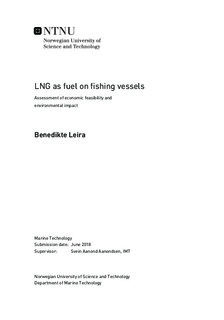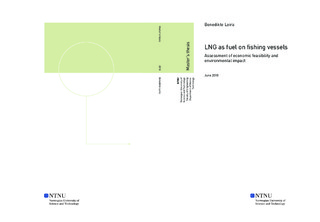| dc.description.abstract | Fisheries have had an important role in the Norwegian economic growth and culture for centuries. While regulatory requirements concerning emission abatement are becoming more demanding, measures aimed at improvement of the environmental profile within the fishing fleet are essential. A transition to more environmentally friendly fuels has been described to be the best measure when the intention is to have a reduction in emissions.
The main argument of utilizing natural gas as fuel is the significant reduction of different pollutants, such as carbon dioxide (CO2), nitrogen oxide (NOx) and sulfur oxide (SOx). In this thesis, an evaluation of liquefied natural gas (LNG) as fuel for fishing vessels is conducted. By assessing both the environmental impact and the economic feasibility, LNG is compared to the conventional fuel utilized on fishing vessels today.
An existing trawler using marine gas oil (MGO) as fuel today, is used as a basis for a performed study case. A part of the case is to incorporate the effect when changing the vessel s dimensions, as a result of a more space demanding LNG system.
To evaluate the environmental impact in a complete way, the entire life cycle is assessed using data from previous life cycle assessment (LCA) studies and conversion methods. The global warming potential (GWP) for the complete life cycle has been estimated to be approximately the same for LNG and MGO, where methane emissions exhausted during the combustion process for LNG accounts for a large amount of the GWP for LNG. The acidification potential and the eutrophication potential show a decrease of approximately 85% compared to MGO, which indicates a lower impact on terrestrial and freshwater ecosystems. There is, however, uncertainty regarding the conversion methods used to evaluate a product s overall impact on the environment, which makes it challenging to draw a final conclusion as to how environmental friendly LNG really is compared to MGO.
It was found that investment in LNG relative to a conventional energy system, will accumulate savings of 25.4 MNOK over 25 years with the financial support from the NOxfund. The LNG-fuelled fishing vessel is also exempt from taxes for CO2 and SOx, and pays a lower tax rate for NOx directly to the funding plan. The payback time will be 3-4 years relative to an MGO baseline when all voyage related expenses are assumed to be constant. During the lifetime of the vessel, it was found that the additional profit will on average increase with 0.18 NOK/kg fish for LNG investment compared to MGO investment. Sensitivity analysis shows that the total cost is highly sensitive towards changes related to tax exemptions and in regards to fuel price dynamics.
Ultimately, regulations are the main driving force for a change to and the adoption of more environmentally friendly technology. Shipowners and important stakeholders make their decisions based on financial gains. As a concluding remark, investing in LNG as fuel can be beneficial considering future regulatory compliance, and will at some level improve a vessel s environmental profile. Based on the findings from the case and current financial benefits, the investment is economically feasible over its anticipated lifetime. However, the vessel used as a basis in the case is not representative for all fishing vessels. Furthermore, tax exemptions, fuel costs, and other voyage related expenses are not constant, which leads to uncertainty regarding future costs and payback time. | |

